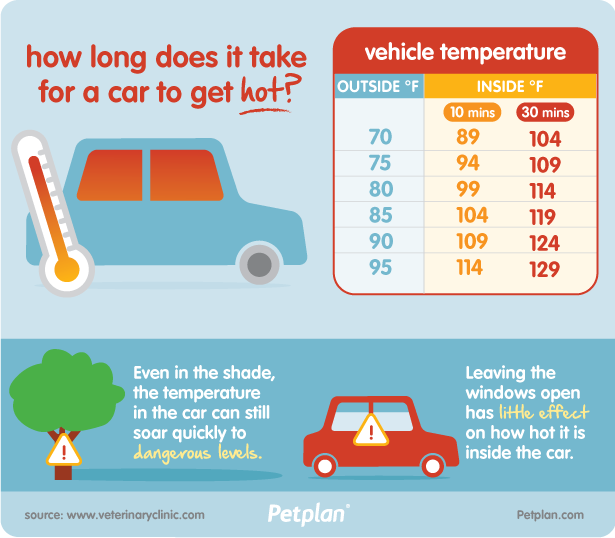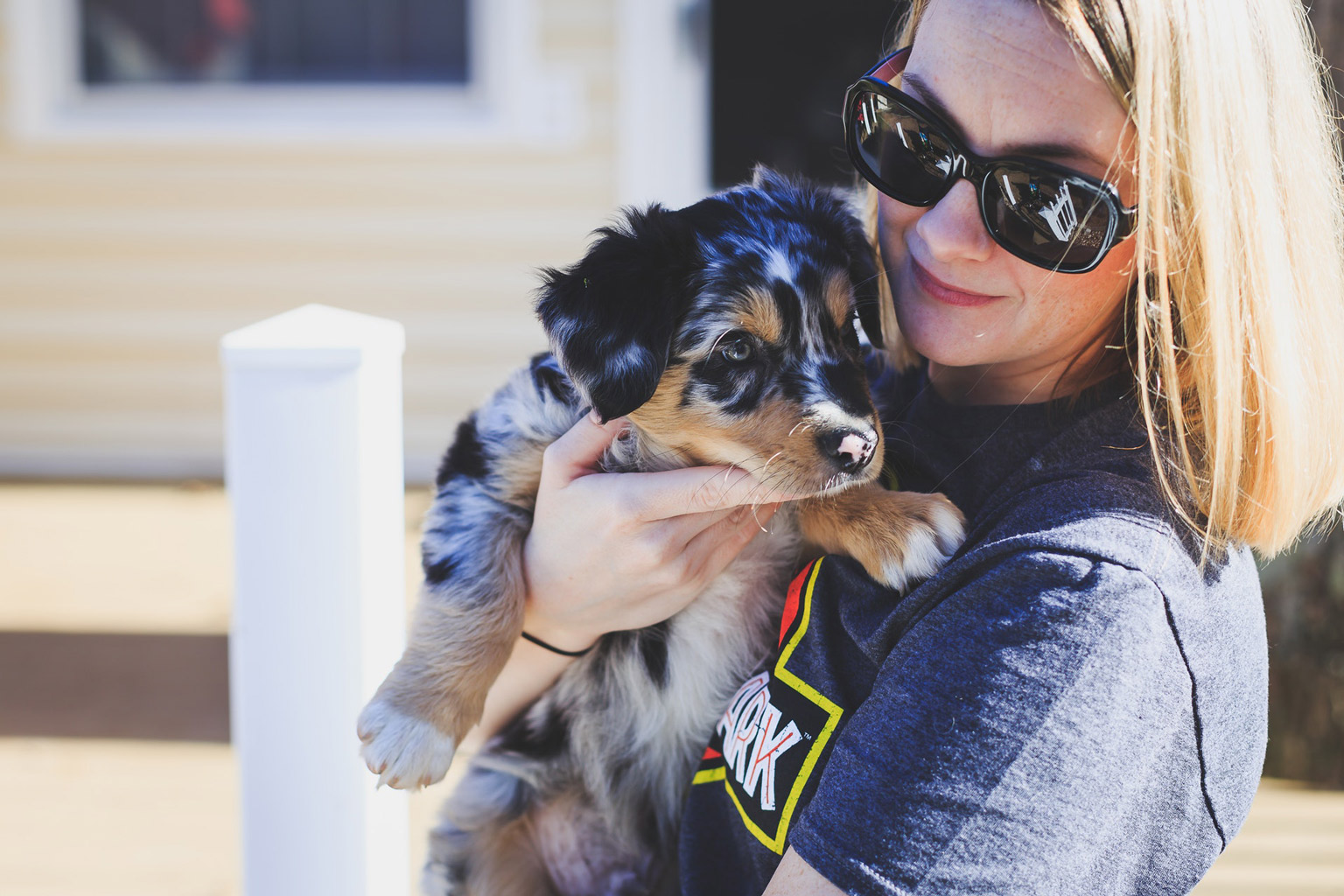
Depending on what part of the world you are, you will be wondering how to get your dog ready for hot or cold weather, no matter if it is summer or wintertime. That’s why I decided to find out what you can do depending on your environment.
So, how do you take care of your dog during vacations? Regardless of the seasonality in your hemisphere or holiday destination, you should keep your dog cool during hot weather, especially at noon. And then during cold weather your dog will need to stay warm, especially for those who have short fur.
Some first-time dog owners are not sure how to take care of their furry friend in different seasons or how to help their dog adjust when they take her on holiday.
There are specific tips for hot and cold season, but also everyday care tips to make informed decisions about how you want to care for your dog.
Dog Care for Summer
Before jumping to the summer tips, let’s define what “hot” means for dogs.
What is a safe temperature for a dog to be outside in the summer?
As a general rule of thumb, if it is too hot or cold for us to be comfortable, it’s too severe for your dog. Hot temperatures, combined with humidity, can cause dehydration and heatstroke.
The risk starts at 23ºC (75ºK) and 29ºC (85ºK) can be dangerous. After that, 32ºC (90ºK) and above is considered potentially life-threatening.
Here’s a chart illustrating the risks of high temperatures for dogs:
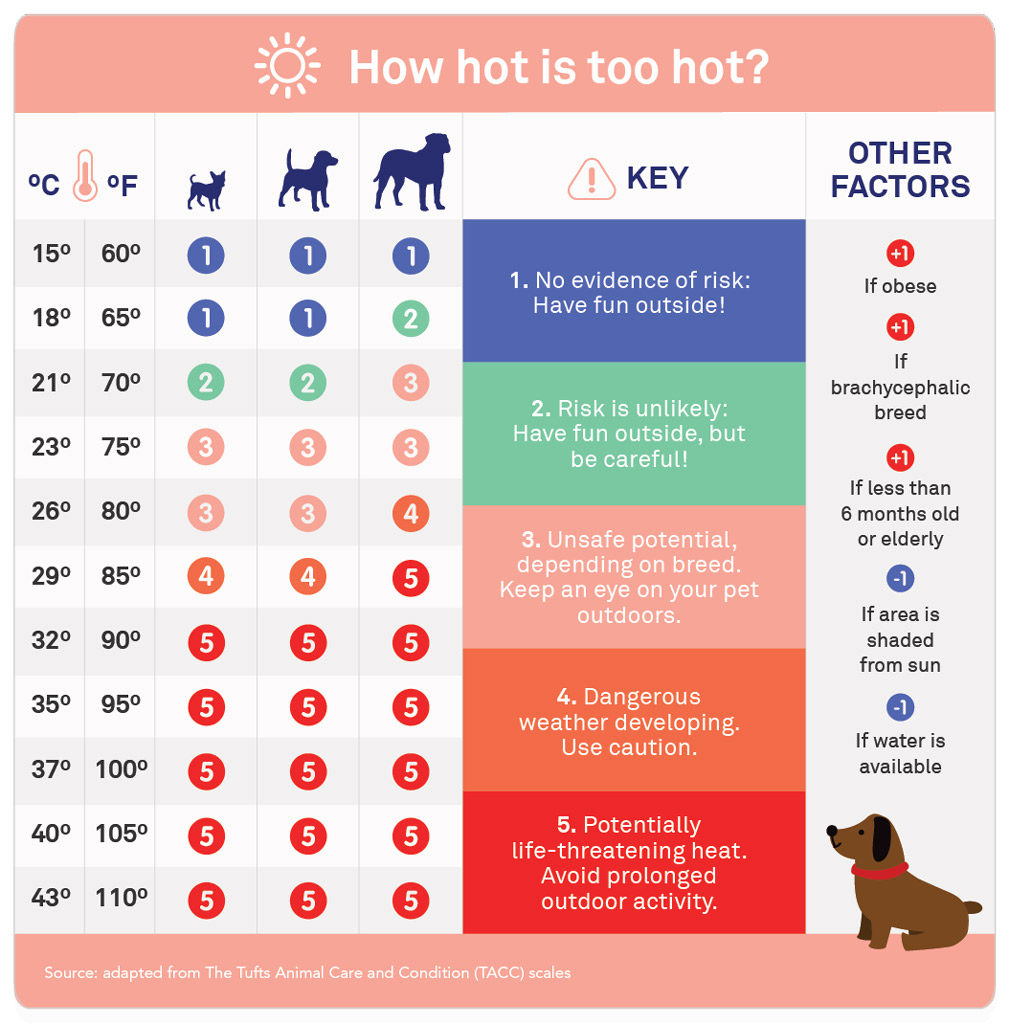
During hot weather, your dog might suffer from hot spots and will need to stay cool. Here are 7 tips you can follow:
#1 – Prevent Dehydration
This is the most important thing that you can do for your furry friend. This means:
- Encourage your dog to stay in the shade, keeping him away from direct sunlight especially at noon.
- Keep your dog hydrated, fill his bowl with cold water and always take water for her if you go for a walk or trip. Travel dog water bottles come in very handy.
- Stay cool, put damp towels for her to lie on.
- If your dog likes water, let her play around with the garden sprinkler or go for a swim (beware, not all dogs are natural swimmers). Alternatively, you can get a little pool like mine for your pooch to refresh herself.
Also, keep an eye for possible dehydration signs:
- Sunken eyes.
- Lethargy.
- Dry mouth.
- Depression.

#2 – Protect Your Dog’s Paws From Hot Surfaces
Hot surfaces can hurt your dog’s paws, particularly sand or tarmac.
How can you know if it’s too hot for your dog?
A simple rule is that if these surfaces feel too hot for you, they probably are too hot for your dog too. Place your palm or naked foot on the surface and test it!
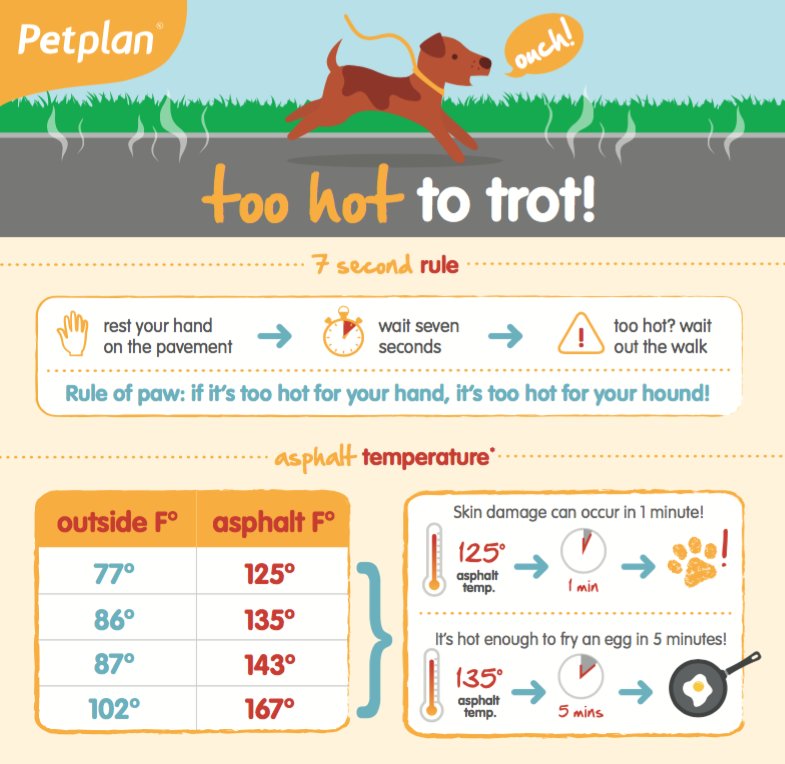
#3 – Keep an Eye for Symptoms of Heat Stroke
Heatstroke happens when dogs can’t reduce their body temperature.
Note: Old and overweight dogs or those with heart and breathing problems are more likely to get heatstroke.
Heatstrokes can be fatal, so look for the following signs:
- Heavy panting.
- Glazed eyes.
- A rapid pulse.
- Excess salivation and thickened saliva.
- Raised temperature (101.5° is normal).
- Fatigue.
- Muscle tremors.
- Lack of coordination or staggering.
- Vomiting or diarrhoea.
- Loss of consciousness.
If you think your dog is having a heatstroke, you need to act fast:
- Take her to a cool, shaded area.
- Get towels soaked in cold water and apply them to her head, neck and chest.
- Encourage her to drink water or lick an ice cube.
Insider Tip: Never place your dog directly into ice-cold water or give her too much to drink, as she may go into shock.
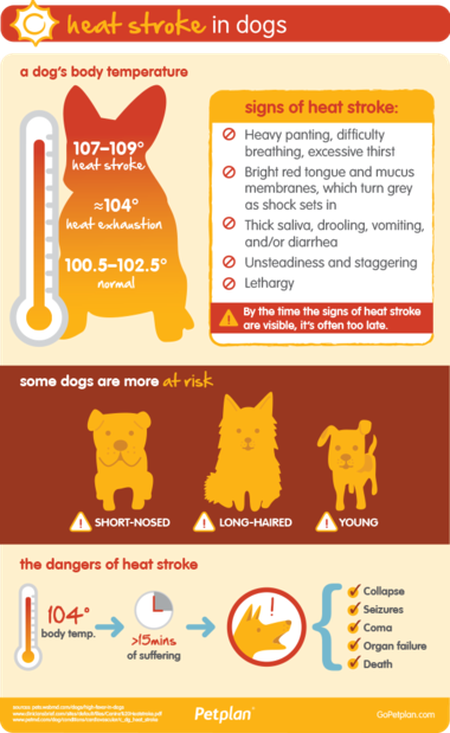
#4 – Plan Your Walks
The goal is to avoid the midday sun. From 11:00 to 15:00 is when the heat of the sun is felt most, which also means it’s the most dangerous.
Early morning and evening walks are the best for both of you to stay cool and avoid getting too hot.
Note: Branchycephallic breeds like Boston Terriers and Pugs are more likely to have breathing difficulty since their smaller airways make it harder for them to release heat when they pant.
Remember that you can also keep your dog busy indoors when it’s too hot outside. 😉
Check Dog Exercise Indoors for more than 10 indoor dog game ideas!
#5 – Clip Your Dog’s Coat
Regular grooming and hair clipping will keep your dog’s coat clean and free of knots.
This is important because matted fur can interfere with their ability to regulate their body temperature and in this case, trap heat.
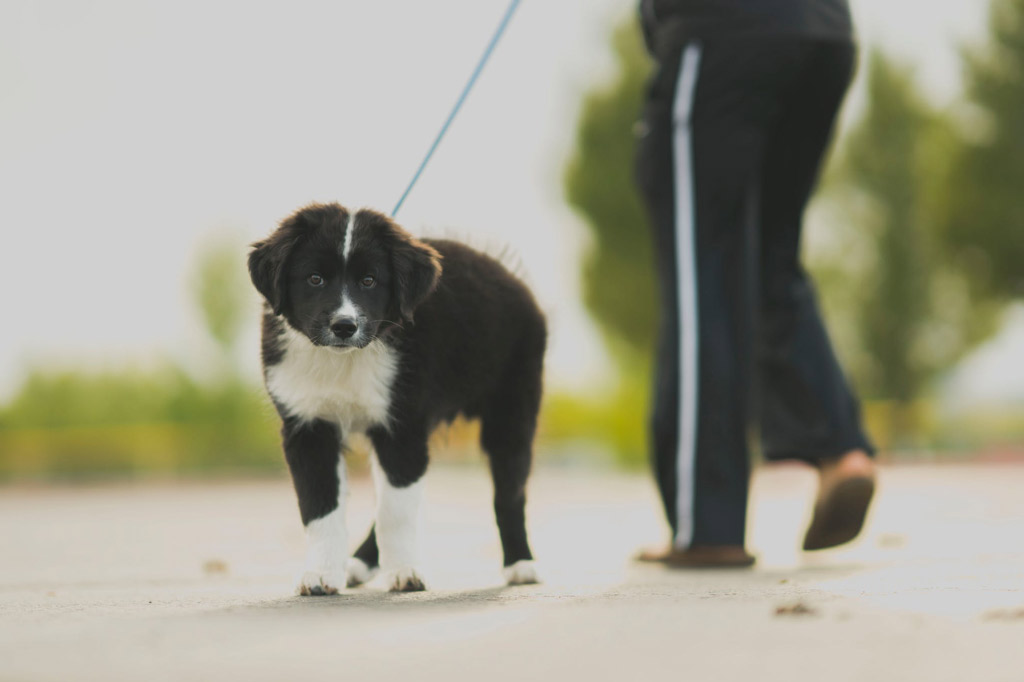
#6 – Reward Your Dog with Frozen Treats
Help your dog cool down from the inside out. You can give your dog:
- Ice cubes with tasty treats inside.
- Frozen blueberries.
- Bone broth cubes.
- Also, you can fill and freeze a chew toy like kongs to make a chilly meal.
For more ideas about healthy treats, check our High-value dog treats blog post.
#7 – Protect Your Dog From Sunburn
Just like us, dogs are at risk of burning in the sun if they’re not protected, particularly those with short fine hair and pink skin.
If you’re unsure whether your dog needs sunscreen, ask your vet and then get sun protection that has been designed specifically for dogs.
Note: The ASPCA says that ingesting certain sunscreens can cause drooling, vomiting, diarrhoea, excessive thirst and lethargy in pets. So, it’s best to read the label carefully and consult your vet when in doubt.
Insider Tip: Limit your Boston’s access to direct sunlight by providing shade in the garden or keeping her indoors during peak hours of the day.
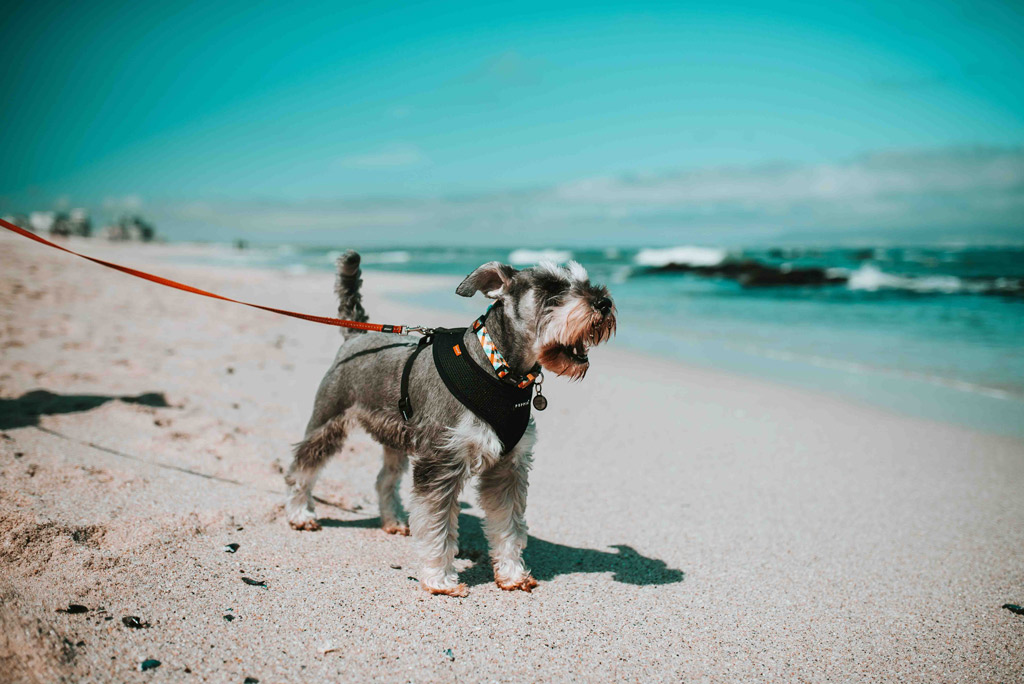
Dog Care for Winter
During cold weather, most dogs will experience the drop in temperature and their coat might not be enough to keep them warm.
You will probably want to make sure that your furry friend stays safe, warm, and comfy all winter long.
Again, before jumping into the tips for winter… let’s define what “cold” is for dogs.
What is a safe temperature for a dog to be outside in winter?
Temperatures lower than 32 degrees Fahrenheit (0 degrees Celcius) can cause hypothermia or frostbite.
Here’s a chart illustrating the risks of low temperatures for dogs:

#1 – Let Your Dog’s Coat Grow
A longer coat will keep your dog warmer, so don’t shave or clip it short during the winter months.
Also, brush your dog regularly, especially if she has long hair since matted fur can interfere with their ability to regulate their body temperature.
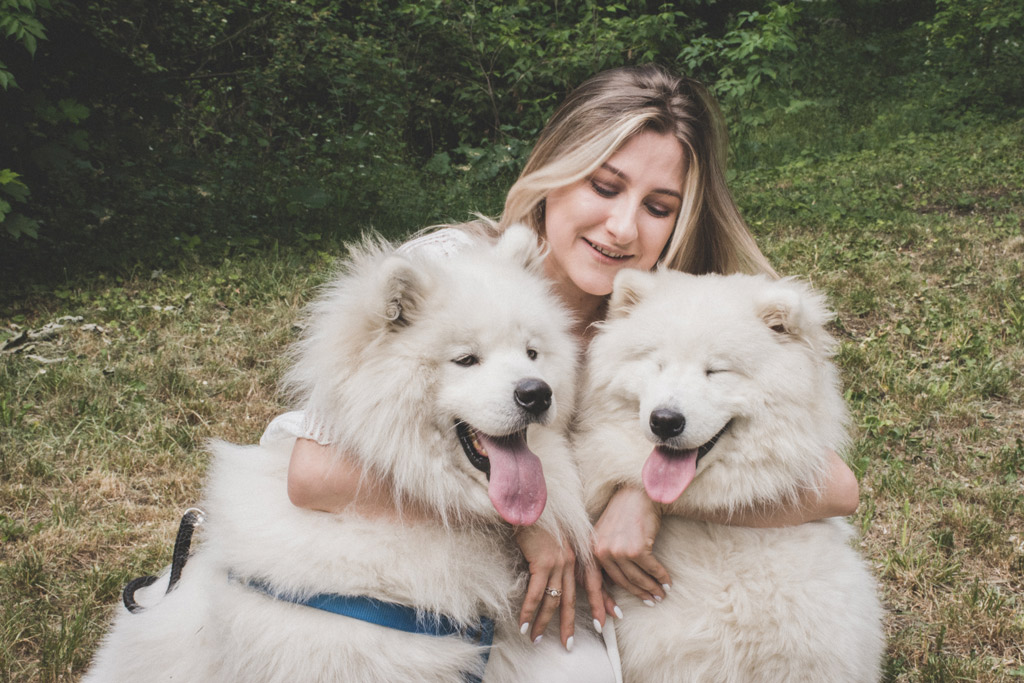
#2 – Prevent Frostbite
Protecting your dog from frostbite and hypothermia is key.
Signs that your dog is uncomfortably cold include:
- Whining.
- Shivering.
- Appearing anxious.
- Slowing down or stopping.
- Looking for a warm place to burrow.
Note: dogs with chronic disease, puppies and older animals are more vulnerable to the cold than healthy youngsters and adults.
If you notice any of these signs, you should:
- Bring your pooch indoors immediately.
- Dry your dog if necessary and offer him warm water.
- To be safe, call your vet to make sure your dog is safe from hypothermia or frostbite.
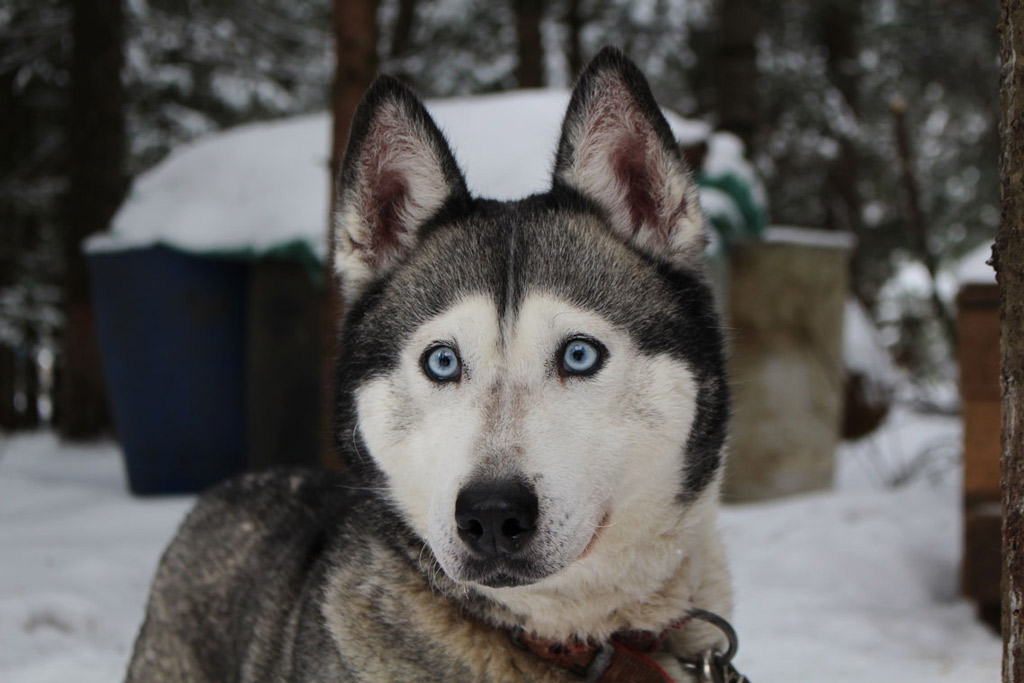
#3 – Provide a Sweater for Shorthaired Dogs
Some dogs won’t wear clothing no matter how chilly they are.
But if your dog tolerates it well,
For facing those cold winter months, you might want to consider:
- Keeping your dog warm on a sunny day: with a knit sweater, a hoodie or a fleece.
- Proofing your pooch against the wind and rain: with a classic poncho, a print raincoat or a waterproof coat.
These are especially practical for shorthaired, older and frail pets.
If your dog is a large breed, he’ll be able to tolerate cold temps and snow much better than a smaller dog.
In addition, keep in mind that dogs lose most of their body heat through the pads of their feet, their ears, and their respiratory tract.
So there’s a limit to how much warmth a sweater or jacket will provide.
Read also: How to Choose a Dog Sweater – Step by Step with Pictures.
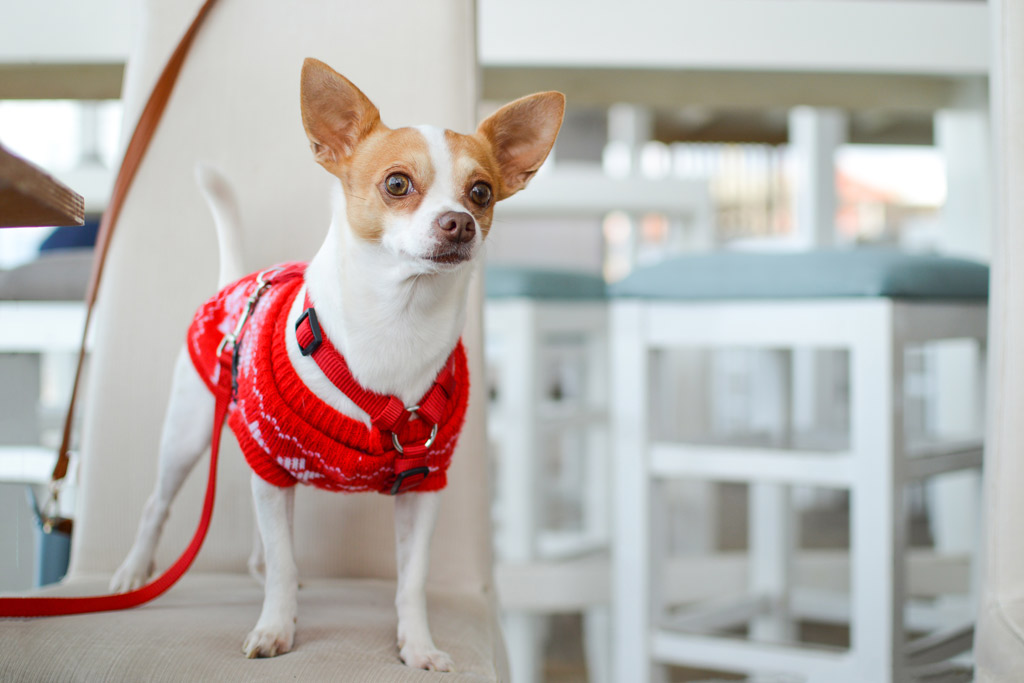
#4 – Keep Your Dog Well-Exercised
It’s really important to maintain your dog’s physical condition year-round.
If you allow your dog to become a couch potato all winter, you increase his risk of injury when she starts exercising again in the spring. Plus, you are also increasing his chances of weight gain due to lack of exercise!
So, continue with the daily walks. Just make sure to keep your pooch on the lead at all times to avoid:
- Your pooch getting lost.
- Getting in contact with antifreeze liquid – just a single teaspoon of this can cause kidney failure.
- Or getting in a dangerous situation like a frozen pond or lake. Dogs can easily fall through the ice, and it’s very difficult for them to escape on their own, or for humans to rescue them.
Don’t forget about mental stimulation!
You can always keep them active indoors playing games, for some ideas check my favourite toys guide.
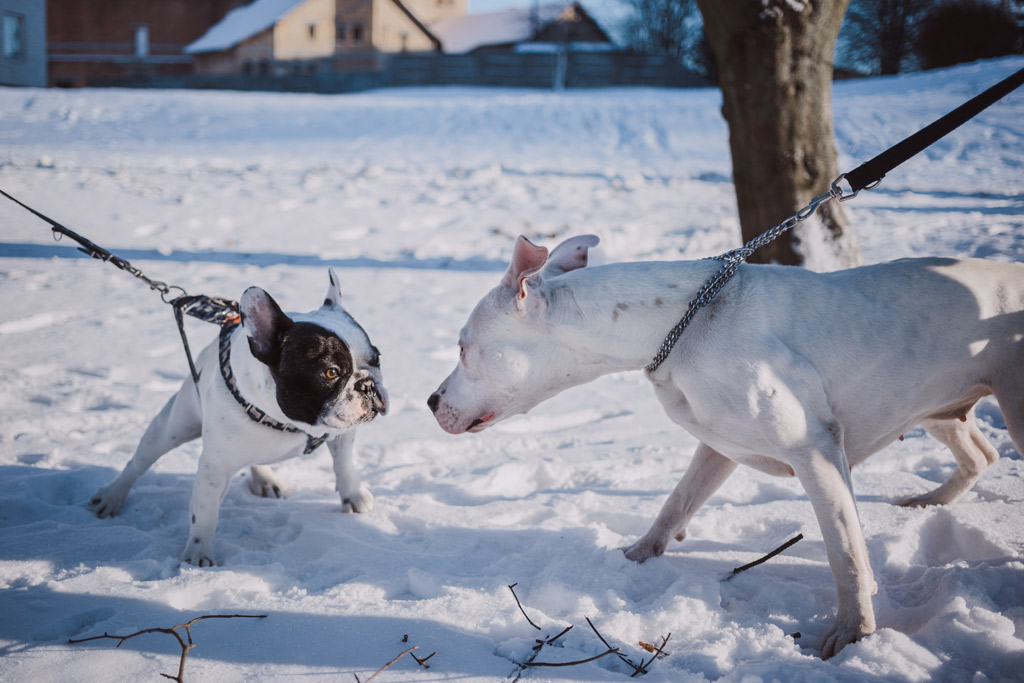
#5 – Protect and Wipe Down Your Dog’s Paws
After a trip outdoors, wipe your dog’s coat and paws.
Dogs who go outside during the winter months can pick up a surprising amount of harmful things like:
- Rock salt.
- Ice.
- Antifreeze.
- And other toxic chemicals during winter.
Especially on their footpads!
So to prevent ingestion of toxins, thoroughly wipe off your dog’s feet, legs and underside after he’s been outside. Personally, I use these dog wipes to do it.
Also, your dog’s paws can become chapped and raw because of the snow or frozen surfaces. So, regularly check your dog’s paws for any signs of injury or bleeding.
Dog booties (browse my Amazon selection) can provide coverage and also prevent salt from getting lodged between bare pads, which causes irritation.
Although boots can be a great solution to protect your dog’s paws, you might find out that your pooch won’t want to wear them!
That’s ok, you could use natural wax instead, like Musher’s, which I find more practical.
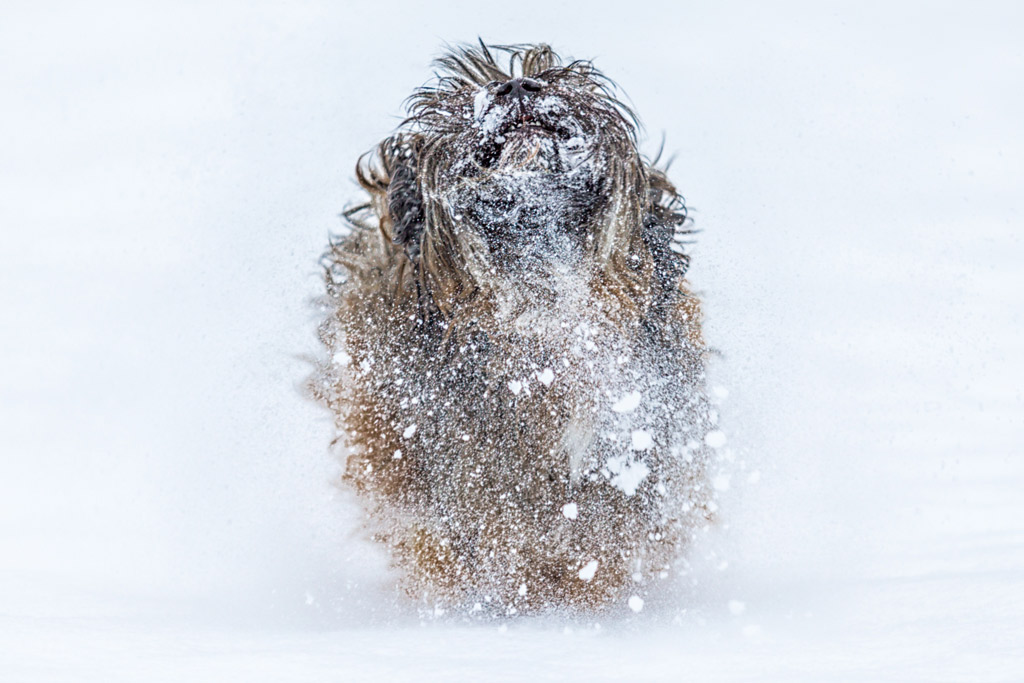
#6 – Be Extra Careful with Senior Dogs
Cold weather can be especially difficult for senior dogs and those with degenerative joint disease or other chronic, debilitating condition.
Talk with your veterinarian about physical therapy and other safe, natural methods for improving your dog’s comfort and mobility during cold weather.
At home, have a thick, soft, non-toxic bed for your dog in a warm room for naps and for bedtime.
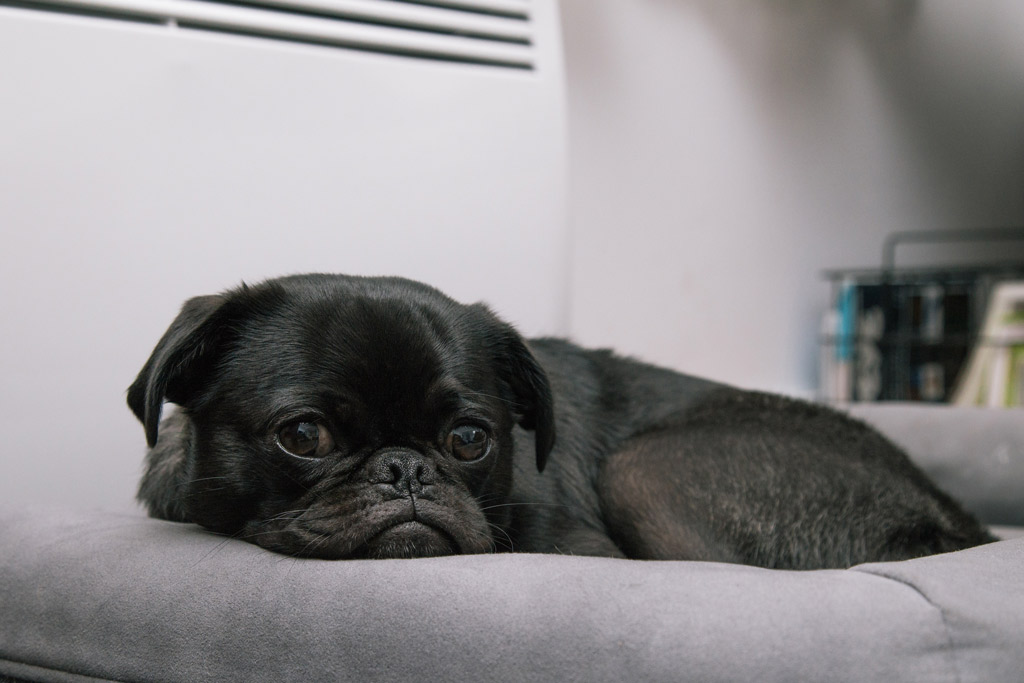
#7 – Prevent Your Dog’s Scaping Chances
More dogs go missing in the winter months than any other time of year. That’s why it’s good to make sure your pet’s ID tag is current and keep her on a lead outdoors.
It’s very easy for your dog to lose her scent and get lost when there’s snow or ice is on the ground.
Plus, light-coloured dogs with snow on their fur can quickly blend into the background, making them nearly impossible to spot.
You can make your dog visible by attaching a small light to her collar. Otherwise, I recommend Tractive, a GPS tracking device attached to your dog’s collar! This will allow you to locate your dog every time. 🙂
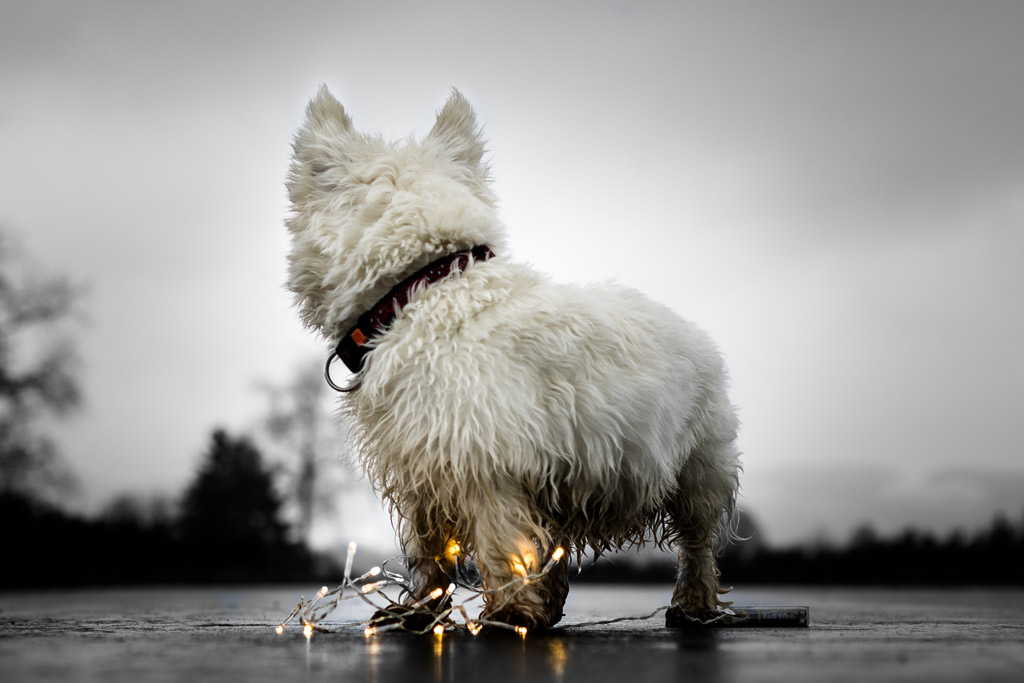
#8 – Have Your Heating System Inspected
It’s a good idea to have your heating unit checked for carbon monoxide leaks before winter sets in.
Carbon monoxide is odourless and invisible, but it can cause serious health problems in both people and pets.
Since your dog very likely spends much more time at home than you do during the winter months, she’s more vulnerable to carbon monoxide poisoning.
#9 – Keep Your Dog Safe from Heat Sources
If you use a fireplace or space heater, expect your dog to lie near it for warmth.
Keep a close watch to ensure no part of her body comes in contact with flames, heating coils or other hot surfaces.
She can easily burn herself or knock a heating unit over and put everyone in the house in danger.

Dog Care for All Seasons
#1 – Take Your Dog for a Wellness Exam
You can go for twice-yearly health exams, especially for senior dogs. So going to the vet in the fall or early winter and before summer starts is a good way to ensure your dog is healthy before the weather changes.
Proactive vets will measure muscle mass, joint range of motion, check vital organ function and make a wellness plan for the upcoming cold months.
Sadly, not everything can be prevented, which is why having dog insurance can especially help you save on vet bills. With Petplan pet insurance, you get the coverage, support and resources you need to be the best pet parent ever. 😉
#2 – Never Leave Your Dog in the Car Unattended
This tip applies for both hot and cold weather.
No matter if the window is down and the car is under the shade during warm weather, or if you leave the car heating on during a cold day, it’s not safe.
Better be safe than sorry! So, plan ahead to avoid having to leave your pooch alone inside the car. The consequences can be fatal. 🙁
